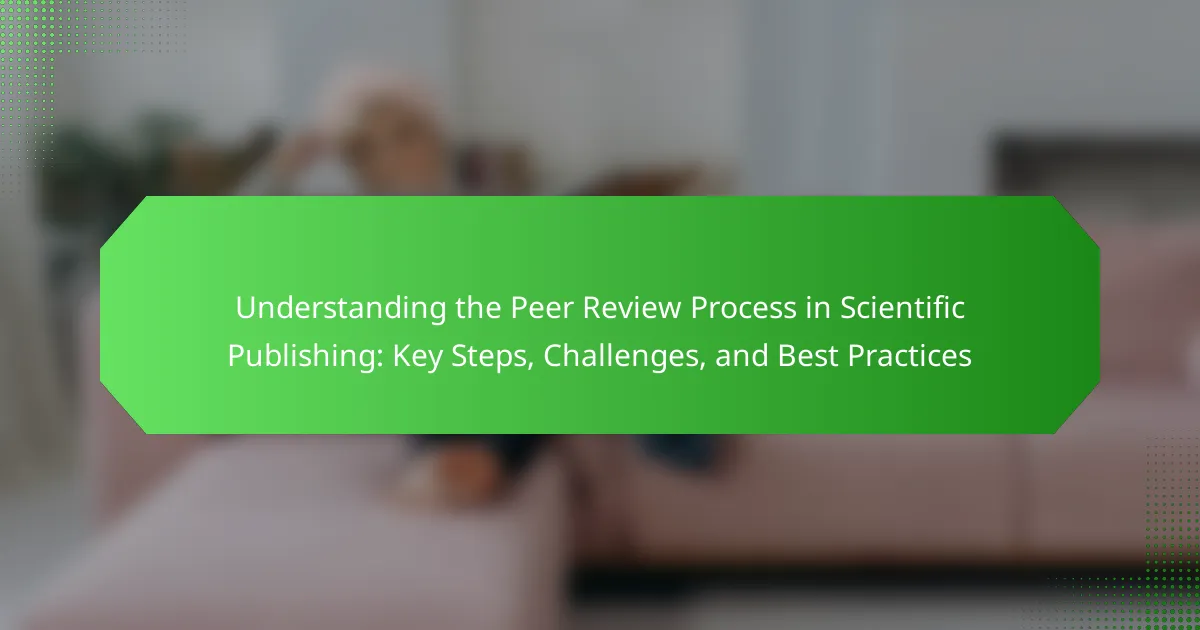The peer review process is a critical evaluation method used in scientific publishing to assess the quality and validity of research before it is published. This process involves multiple key steps, including manuscript submission, initial evaluation by journal editors, peer review by experts, and final publication decisions. While peer review enhances the integrity of published research, it faces challenges such as reviewer bias, time delays, and conflicts of interest. Authors can improve their chances of successful publication by adhering to best practices, including following journal guidelines, providing clear summaries, and responding thoughtfully to reviewer feedback. Understanding these elements is essential for navigating the peer review landscape effectively.
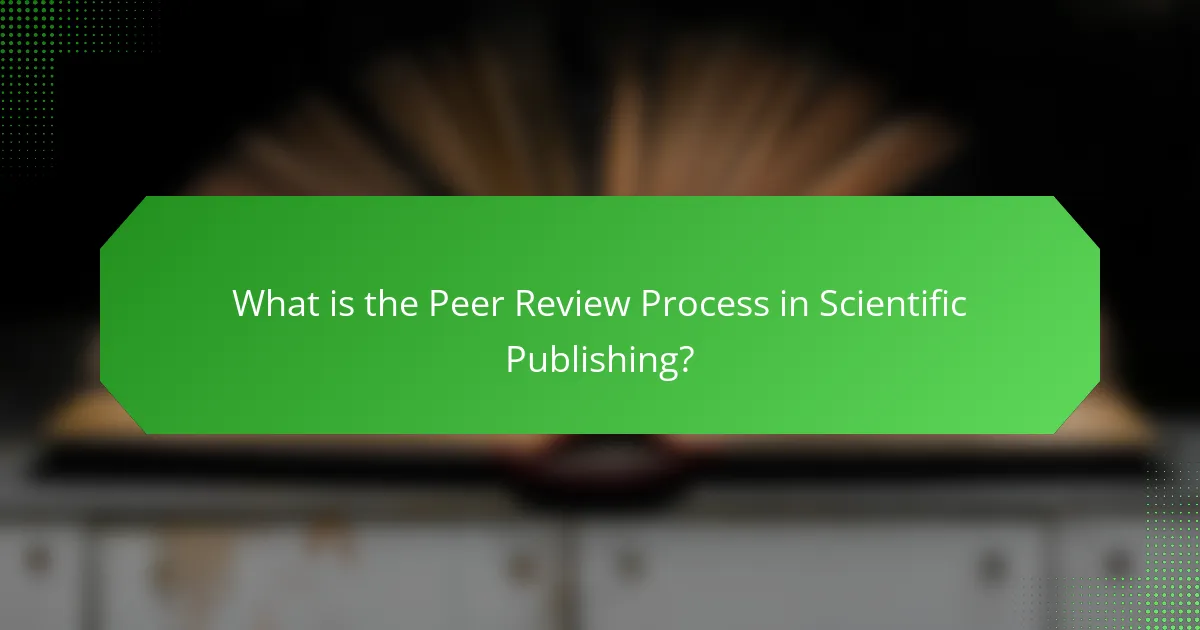
What is the Peer Review Process in Scientific Publishing?
The peer review process in scientific publishing is a method used to evaluate the quality and validity of research before publication. It involves the submission of a manuscript to a journal, where it is reviewed by experts in the field. These experts assess the research for originality, significance, and methodological rigor. They provide feedback and recommendations to the journal’s editor. Based on this feedback, the editor decides whether to accept, revise, or reject the manuscript. This process helps ensure that published research meets high academic standards. Studies show that peer-reviewed articles are more likely to be reliable and influential in their fields.
How does the peer review process function?
The peer review process functions as a method for evaluating scholarly work. It involves several key steps. First, an author submits a manuscript to a journal. The journal editor then screens the submission for relevance and quality. If deemed suitable, the editor sends the manuscript to experts in the field for review. These reviewers assess the work for originality, validity, and significance. They provide feedback and recommendations on whether to accept, revise, or reject the manuscript. The editor considers the reviewers’ comments and makes the final decision. This process ensures the integrity and quality of published research. Studies show that peer-reviewed articles are generally more reliable than non-reviewed ones.
What are the main stages of the peer review process?
The main stages of the peer review process are submission, initial evaluation, peer review, decision, and publication. In the submission stage, authors submit their manuscript to a journal. The initial evaluation stage involves the editorial team assessing the manuscript for suitability. During the peer review stage, experts evaluate the manuscript for quality and validity. The decision stage follows, where the editor makes a final call on publication based on peer reviews. Finally, in the publication stage, the approved manuscript is published in the journal. These stages ensure the integrity and quality of scientific literature.
How do reviewers assess the quality of a manuscript?
Reviewers assess the quality of a manuscript through several criteria. They evaluate the originality and significance of the research. Reviewers check if the manuscript contributes new knowledge to the field. They also analyze the clarity and coherence of the writing. The methodology is scrutinized for rigor and appropriateness. Reviewers look for proper data analysis and interpretation. They assess the relevance and accuracy of the references used. Ethical considerations in the research are also evaluated. These assessments help determine the manuscript’s suitability for publication.
Why is the peer review process important in scientific publishing?
The peer review process is important in scientific publishing because it ensures the quality and credibility of research. This process involves experts evaluating a manuscript before publication. They assess the validity, significance, and originality of the work. Peer review helps identify errors and biases in research. It also provides constructive feedback to authors, improving the overall quality of published studies. Studies show that peer-reviewed articles are more reliable than non-peer-reviewed ones. According to a 2019 analysis in the journal “PLOS ONE”, peer-reviewed research is cited more frequently, indicating its acceptance in the scientific community. Thus, peer review is essential for maintaining scientific integrity and advancing knowledge.
What role does peer review play in maintaining scientific integrity?
Peer review plays a critical role in maintaining scientific integrity. It involves independent experts evaluating research before publication. This process helps ensure accuracy, validity, and originality of findings. Peer review acts as a quality control mechanism. It identifies errors and biases that authors may overlook. Studies show that peer-reviewed articles are more reliable than non-reviewed ones. For example, a 2016 analysis found that peer-reviewed research is less likely to be retracted. This process fosters trust in scientific literature. Overall, peer review is essential for upholding standards in research and publication.
How does peer review contribute to the advancement of knowledge?
Peer review enhances the advancement of knowledge by ensuring the quality and credibility of research. It involves experts evaluating a study before publication. This process identifies flaws in methodology, analysis, or interpretation. It helps refine research questions and hypotheses. Peer review also promotes transparency and reproducibility in scientific work. A study published in the journal “Nature” found that peer-reviewed articles are more likely to be cited than non-reviewed ones. This highlights the role of peer review in establishing trust in scientific findings. Ultimately, it fosters a culture of critical evaluation and improvement in research.
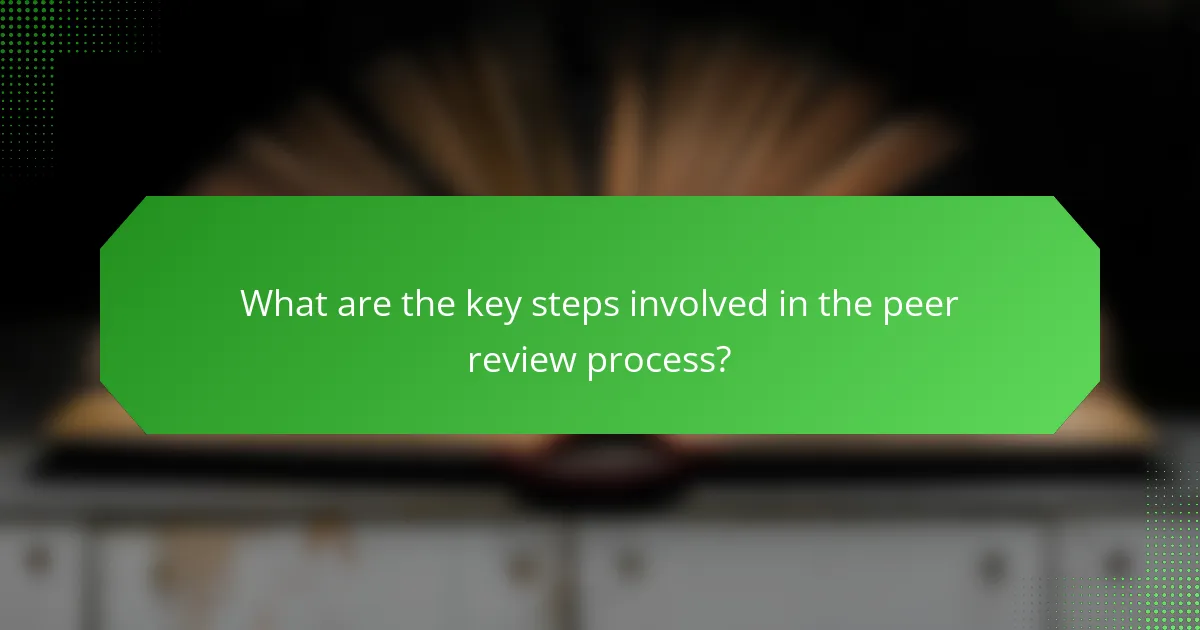
What are the key steps involved in the peer review process?
The key steps involved in the peer review process are submission, initial evaluation, peer review, decision, and publication. First, authors submit their manuscript to a journal. The journal editor conducts an initial evaluation to determine if it fits the journal’s scope. Next, the manuscript is sent to experts in the field for peer review. These reviewers assess the quality, validity, and originality of the research. After receiving feedback, the editor makes a decision to accept, revise, or reject the manuscript. If accepted, the manuscript proceeds to publication in the journal. Each step ensures the integrity and quality of scientific research.
How is a manuscript selected for peer review?
A manuscript is selected for peer review based on its relevance and quality. Editors evaluate submissions to ensure they fit the journal’s scope. They assess originality, significance, and methodological rigor. Manuscripts that meet these criteria are sent to experts in the field for evaluation. The peer review process aims to validate research findings and improve manuscript quality. This selection process helps maintain academic standards in publishing.
What criteria are used to choose reviewers for a manuscript?
Reviewers for a manuscript are chosen based on expertise, availability, and impartiality. Expertise ensures that reviewers have sufficient knowledge of the subject matter. Availability confirms that reviewers can dedicate time to complete the review promptly. Impartiality guarantees that reviewers do not have conflicts of interest with the authors. These criteria help maintain the integrity and quality of the peer review process.
How does the editorial team manage the review process?
The editorial team manages the review process through structured protocols. They begin by selecting appropriate reviewers based on expertise. Reviewers assess the manuscript’s quality and relevance. The team facilitates communication between authors and reviewers. They compile feedback and make recommendations for revisions. The editorial team ensures adherence to publication standards. They also track the review timeline to maintain efficiency. This organized approach enhances the integrity of the peer review process.
What happens during the review phase?
During the review phase, submitted manuscripts are evaluated by experts in the field. Reviewers assess the quality, validity, and originality of the work. They provide feedback and recommendations for improvement. The review process typically lasts several weeks to months. Authors may receive requests for revisions based on reviewer comments. The editorial team considers reviewer suggestions before making a publication decision. This phase is crucial for ensuring scientific rigor and integrity. Studies show that peer-reviewed articles have higher credibility and impact in the scientific community.
What types of feedback do reviewers provide?
Reviewers provide several types of feedback during the peer review process. They typically assess the quality of the research, including its methodology and results. Reviewers comment on the clarity and organization of the manuscript. They also evaluate the relevance and significance of the findings. Additionally, reviewers may suggest improvements or revisions to enhance the paper. They often provide insights on the literature review and references used. Reviewers may point out any ethical concerns related to the research. Overall, their feedback aims to improve the manuscript before publication.
How are revisions handled after the initial review?
Revisions after the initial review are typically handled through a structured process. Authors receive feedback from reviewers, highlighting necessary changes. They are then required to address these comments in a revised manuscript. The revised manuscript is usually resubmitted for further evaluation. Reviewers may assess whether the revisions adequately address their concerns. This process can involve multiple rounds of revisions. Each round aims to enhance the manuscript’s quality. Ultimately, acceptance depends on satisfactorily meeting the reviewers’ expectations. This systematic approach ensures thorough evaluation and improvement of scientific work.
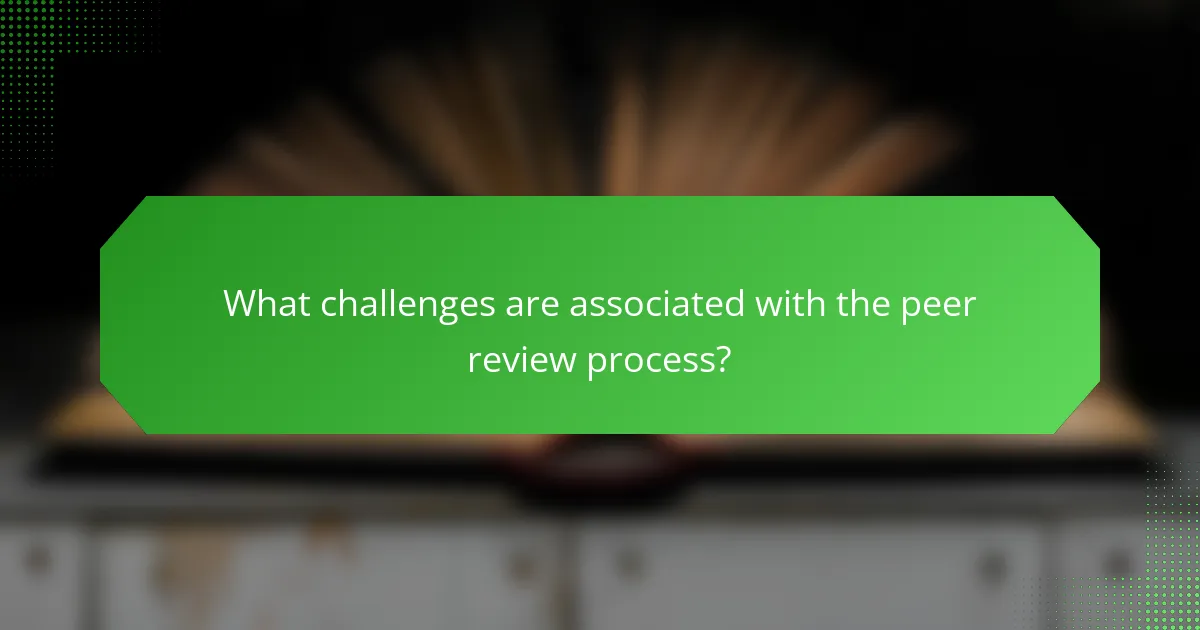
What challenges are associated with the peer review process?
The peer review process faces several challenges. One major challenge is reviewer bias, which can affect the objectivity of evaluations. Studies show that biases related to gender, institution, or nationality can influence reviewer decisions. Another challenge is the time-consuming nature of the process. It often takes several months for reviews to be completed, delaying publication. Additionally, there is a shortage of qualified reviewers in many fields. This shortage can lead to extended wait times and lower quality reviews. Conflicts of interest also pose a problem. Reviewers may have personal or professional ties to the authors, impacting their impartiality. Lastly, the pressure to publish can lead to rushed or incomplete reviews. These challenges collectively undermine the effectiveness of the peer review process.
What common issues arise during peer review?
Common issues during peer review include bias, lack of expertise, and delays. Bias can arise when reviewers have personal or professional conflicts of interest. This may lead to unfair evaluations of the manuscript. Lack of expertise occurs when reviewers are not sufficiently knowledgeable about the subject matter. This can result in inadequate feedback and oversight. Delays often happen due to reviewers taking too long to assess the manuscript. According to a study published in the journal “Nature,” peer review can take an average of 3-6 months, impacting publication timelines. Other issues include unclear feedback and inadequate communication between authors and reviewers. These factors can hinder the overall effectiveness of the peer review process.
How does bias affect the peer review process?
Bias negatively impacts the peer review process by influencing the evaluation of research quality. It can lead to unfair assessments based on personal beliefs or affiliations. For example, reviewers may favor studies that align with their own views. This can result in biased acceptance or rejection of manuscripts. Research shows that gender bias exists, with female authors facing higher rejection rates. A study by Budden et al. (2008) found that male authors were more likely to be published than female authors in ecology journals. Additionally, confirmation bias may prevent reviewers from objectively assessing new findings. Such biases undermine the integrity of the scientific publication process.
What are the challenges of finding qualified reviewers?
Finding qualified reviewers is challenging due to several factors. One major issue is the limited pool of experts in specific fields. Many researchers are already overcommitted with their own projects. This creates a shortage of available reviewers. Additionally, identifying reviewers with the right expertise can be difficult. Reviewers must not only have knowledge of the subject but also be unbiased. Conflicts of interest can further complicate the selection process. Lastly, the time required for a thorough review often deters potential reviewers. These challenges contribute to delays in the peer review process.
How can the peer review process be improved?
The peer review process can be improved by enhancing transparency and efficiency. Implementing open peer review allows for greater accountability among reviewers. This process enables authors to see reviewer comments, fostering constructive feedback. Additionally, utilizing technology can streamline submissions and tracking. Automated systems can reduce administrative burdens and speed up the review timeline. Establishing clear guidelines for reviewers can ensure consistency in evaluations. Training programs for reviewers can improve the quality of feedback provided. Research indicates that these strategies lead to higher satisfaction among authors and reviewers alike. For instance, a study from the journal “Nature” highlights improved outcomes with open peer review practices.
What best practices can enhance the efficiency of peer review?
Best practices that can enhance the efficiency of peer review include clear guidelines for reviewers and authors. Providing structured templates helps streamline the review process. Timely reminders for deadlines keep reviewers accountable. Utilizing specialized software can facilitate communication and document management. Encouraging constructive feedback promotes a more effective review. Training programs for reviewers improve their skills and understanding. Implementing double-blind review can reduce bias and enhance fairness. Regularly assessing the peer review process allows for continuous improvement.
How can transparency be increased in the peer review process?
Transparency in the peer review process can be increased by implementing open peer review practices. Open peer review allows for the reviewer’s identities to be disclosed to authors and vice versa. This approach fosters accountability and encourages constructive feedback. Additionally, publishing peer review reports alongside accepted articles enhances transparency. According to a study published in the journal “Nature,” transparency in peer review can boost trust in the scientific process. Furthermore, utilizing platforms that allow for public commentary on manuscripts can also contribute to a more open review system. These methods collectively promote a culture of openness and trust within scientific publishing.
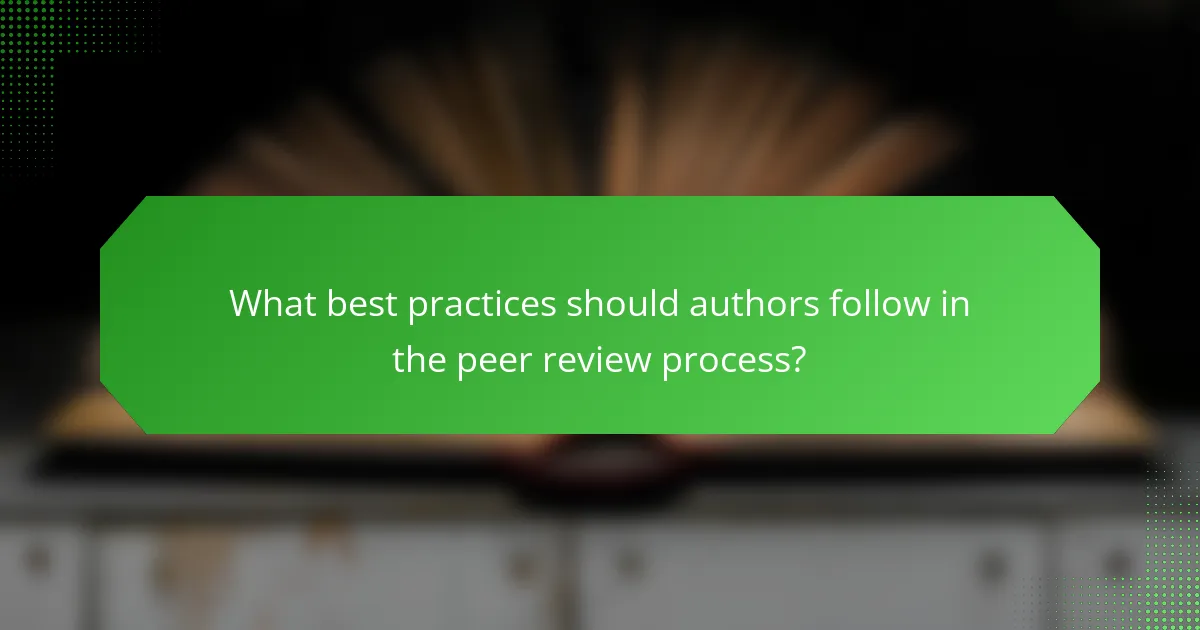
What best practices should authors follow in the peer review process?
Authors should follow several best practices in the peer review process. First, they should ensure their manuscript meets the journal’s guidelines. This includes formatting, length, and citation style. Second, authors must provide a clear and concise summary of their research. This helps reviewers understand the main contributions quickly. Third, authors should suggest potential reviewers. This can facilitate a smoother review process. Fourth, authors need to respond to reviewer comments thoughtfully. Addressing feedback shows respect for the reviewers’ expertise. Fifth, maintaining transparency about conflicts of interest is crucial. This builds trust in the review process. Lastly, authors should be patient and professional throughout the process. Peer review can take time, and professionalism is essential for constructive communication.
How can authors prepare their manuscript for submission?
Authors can prepare their manuscript for submission by following specific guidelines. They should first ensure their manuscript adheres to the journal’s formatting requirements. This includes the correct structure, citation style, and word count. Authors must also conduct a thorough review of their work for clarity and coherence. It is essential to check for grammatical errors and typos. Additionally, including a well-crafted abstract is crucial, as it summarizes the key findings. Authors should also prepare a cover letter that outlines the significance of their research. Finally, ensuring compliance with ethical standards, such as proper citation and conflict of interest disclosures, is necessary. These steps increase the likelihood of a successful submission.
What common mistakes should authors avoid during submission?
Authors should avoid several common mistakes during submission. One mistake is failing to follow the journal’s submission guidelines. Each journal has specific requirements for formatting and content. Ignoring these can lead to immediate rejection. Another mistake is not thoroughly proofreading the manuscript. Typos and grammatical errors can undermine the author’s credibility. Authors should also avoid submitting to multiple journals simultaneously. This practice is considered unethical and can damage reputations. Additionally, authors often forget to include necessary supplementary materials. Missing data can hinder the review process. Lastly, authors should not underestimate the importance of a well-crafted cover letter. A strong cover letter can enhance the submission’s overall impression.
How can authors effectively respond to reviewer comments?
Authors can effectively respond to reviewer comments by addressing each comment systematically. They should first read all comments carefully to understand the reviewers’ concerns. Authors must organize their responses by categorizing comments into major and minor issues. Each response should directly reference the specific comment number or text. Authors should provide clear explanations for changes made or justify reasons for not making suggested changes. It is important to maintain a professional and respectful tone throughout the response. Authors can enhance their responses by including additional data or references when necessary. This structured approach demonstrates authors’ commitment to improving their work and facilitates constructive dialogue with reviewers.
What tips can improve the peer review experience?
To improve the peer review experience, clear communication is essential. Reviewers should provide constructive feedback that is specific and actionable. Authors benefit from understanding the reviewer’s perspective. Setting realistic deadlines helps manage expectations for both parties. Regular follow-ups can keep the process on track. Encouraging open dialogue fosters collaboration and enhances understanding. Utilizing structured review forms can streamline the feedback process. Training for reviewers can improve the quality of reviews overall.
How can authors select the right journal for their work?
Authors can select the right journal for their work by evaluating several key factors. First, they should identify journals that align with their research topic. This ensures a relevant audience and increases the chances of acceptance. Next, authors should consider the journal’s scope and aims, which are typically outlined on the journal’s website. Understanding the target audience helps in making an informed choice.
Authors should also review the journal’s impact factor and reputation within the field. Journals with higher impact factors often have wider reach and influence. Additionally, examining recent articles published in the journal can provide insight into the types of studies that are favored. This can help authors tailor their submissions accordingly.
Another important factor is the journal’s review process and publication timeline. Some journals offer faster review times, which may be crucial for time-sensitive research. Authors should also check for open access options if wider accessibility is a priority.
Finally, consulting with colleagues or mentors can provide valuable recommendations based on their experiences. This collaborative approach can further refine the selection process.
What strategies can authors use to engage with reviewers constructively?
Authors can engage with reviewers constructively by responding thoughtfully to feedback. This involves carefully reading each comment and addressing them directly. Authors should express gratitude for the reviewers’ insights. Acknowledging the value of their perspectives fosters a positive dialogue. Additionally, providing clear explanations for any disagreements is crucial. Authors should justify their decisions with evidence from the literature. Maintaining a professional tone throughout the communication is essential. Timely responses show respect for the review process. Ultimately, these strategies enhance the likelihood of a favorable outcome in the peer review process.
The main entity of this article is the peer review process in scientific publishing. This process is critical for evaluating the quality and validity of research prior to publication, involving key stages such as submission, initial evaluation, peer review, decision, and publication. The article outlines how reviewers assess manuscripts based on originality, significance, and methodological rigor while discussing the importance of peer review in maintaining scientific integrity and advancing knowledge. Additionally, it addresses challenges such as bias and delays, and provides best practices for authors to enhance their submission and engagement with reviewers.
